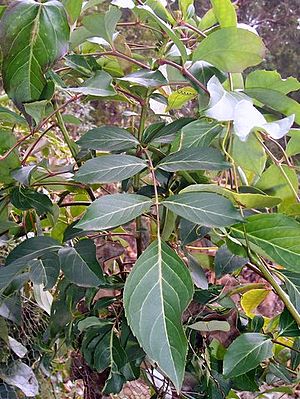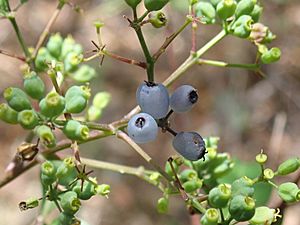Elderberry panax facts for kids
Quick facts for kids Elderberry panax |
|
|---|---|
 |
|
| Polyscias sambucifolia subsp. sambucifolia growing near Brisbane Water National Park, Australia | |
 |
|
| Fruit (McKay Reserve, Palm Beach, New South Wales) | |
| Scientific classification | |
| Genus: |
Polyscias
|
| Species: |
sambucifolia
|
| Synonyms | |
|
Panax sambucifoliusSieber ex DC. |
|
Polyscias sambucifolia, often called elderberry panax or small basswood, is a plant that grows naturally in eastern Australia. It's a type of tree or shrub. You can find it in places like Victoria, New South Wales, and Queensland. This plant is known for its interesting leaves and small, colorful fruits.
Contents
How Elderberry Panax Got Its Name
The elderberry panax was first described in 1830. A scientist named Franz Sieber gave it the name Panax sambucifolius. Later, in 1894, a German botanist named Hermann Harms gave it its current scientific name, Polyscias sambucifolia.
Scientists have studied this plant a lot. They found that there are three main types, or subspecies, of Polyscias sambucifolia. These are called sambucifolia, decomposita, and leptophylla. People also call this plant by other common names. These include small basswood, elderberry panax, ornamental ash, and elderberry ash.
What Does Elderberry Panax Look Like?
Elderberry panax can grow quite tall. Some trees reach up to 11 metres (about 36 feet) high. Their trunks can be about 20 centimetres (8 inches) wide. You can see these large trees in places like Errinundra National Park and Otway National Park in Victoria.
The trunk of the tree is usually straight. The bark is dark brown or black. It feels fairly smooth. You might notice small bumps or lines on the bark.
Leaves of the Plant
The leaves of the elderberry panax are very interesting. They can look different depending on the subspecies. You can find detailed descriptions of each type on plant websites.
The leaves are made up of many smaller leaflets. This is called a pinnate or bipinnate leaf. Each leaf stem can have between one and six pairs of these leaflets.
- Subspecies sambucifolia: The leaflets are shaped like an egg and have small teeth along their edges.
- Other subspecies: Their leaves do not have teeth.
Leaflets can be from 2 to 20 centimetres (about 1 to 8 inches) long. The top side of the leaves is shiny green. The underside is a dull, bluish-green color. There is often a single leaflet at the very end of the compound leaf.
The leaf stalks also vary in length. Some are 20 millimetres long. In the leptophylla subspecies, the leaflets attach directly to the stem with no stalk. These leaflets are long, narrow, and slightly curved. The decomposita subspecies has leaves that are often two or three times divided.
You can easily see the veins on both sides of the leaves. They look a bit sunken on the top surface. On the underside, the veins are raised.
Flowers and Fruit
The elderberry panax produces yellow-green flowers. These flowers grow in clusters called panicles. They usually appear from December to February.
After the flowers, the plant grows small fruits. These fruits are round and edible. They are about 4 to 6 millimetres long. The fruits are often mauve or blue in color. Each fruit contains one or two tiny seeds, about 2 millimetres long. The fruits ripen between January and April.
Where Does Elderberry Panax Grow?
This plant grows naturally along the eastern coast of Australia. Its range stretches from Cape Otway in Victoria in the south. It goes all the way up to the McPherson Range in the north. This range is on the border between New South Wales and Queensland. You will often see elderberry panax growing at the edge of rainforests.
Animals and Elderberry Panax
Many animals interact with the elderberry panax. Birds like Currawongs enjoy eating its fruit. There is also a type of caterpillar called the elderberry panax leaf roller. These caterpillars eat the leaves of the plant.
Uses of Elderberry Panax
People like elderberry panax because of its pretty leaves and colorful fruit. It is an attractive plant.
See also
 In Spanish: Polyscias sambucifolia para niños
In Spanish: Polyscias sambucifolia para niños

